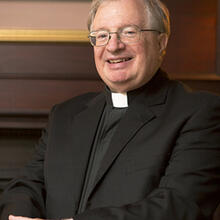The Canadian philosopher Charles Taylor, the winner of this years Templeton Prize, has written an 800-page book, A Secular Age(Harvard Univ. Press), explaining our present religious situation. His thesis is that secularity consists in having multiple options to express the religious impulse. A few, like the Stoics of old, may choose an exclusive humanism that rejects issues of ultimacy. But most people will choose some available option to explore and express their religious sensibilities or assemble their own religion in a bricolage of symbols and practices.
Taylors theory only reflects the communities and families we live in. I think of another family I know and love. For me they have been part of the hundredfold. Over the years I have celebrated marriages, baptisms and funerals for one family member or another. Of several grown children, one is leader of a charismatic community, another is active in a progressive parish, another has become an Episcopalian, others are Christmas and Easter Catholics, one has become a Jew, and other siblings have no religious practice I know of. More than once, moreover, I have witnessed parents follow their adult children into lax observance.
I must confess, as a priest I have muddled along with all this diversity, doing my best to provide pastoral care in limited ways, give spiritual guidance and bear witness to Jesus Christ as good news for humanity. Reading Taylor, however, brought me a moment of recognition. Ministry in this context is an entirely new challenge. How will the church carry out its work where the options are so many, and people are free to decide for themselves how to embrace the holy?
Taylor has some thoughts. He worries about what he terms excarnation, the increasing tendency of western Christianity to be a faith of the head only, neglecting the bodys role in apprehending the divine. He would be inclined to encourage a sacramental faith, in which prayer and liturgy involve the body. With impressive knowledge of the history of Christian spirituality, Taylor would appreciate the demands of discipline in prayer, but he wouldnt be too concerned about rubrical niceties either.
What would be important is what St. Ignatius called the progress of souls, that is, greater savor of the holy on the part of those who are already naturally receptive to the divine through sensate experience; and for us heady types, greater experimentation with embodied ways of apprehending God. I think of the Australian feminist Germaine Greer, a onetime Catholic, who found herself drenched in tears after listening to the chant at a Russian Orthodox Mass. The music brought her back to the faiththough not to the church.
Taylor praises large religious gatherings and movements that are opportunities for seekers to experience the community of faith in a relatively undemanding way, like the annual treks of young people to the ecumenical monastery of Taizé, France. He includes World Youth Day in this class of activities, overlooking the catechetical sessions that punctuate the program. Ask the young people, though, and it is the collective experience of faith, not the words of instruction, they remember. We must rediscover, Taylor insists, festivity as part of religious practice.
Pope Benedict XVI might approve of these moves. Perhaps the church has forgotten, he wrote in Without Roots, that the tree of the kingdom of God reaches beyond the branches of the visible church, but that is precisely why it must be a hospitable place in whose branches many guests find a place. If Benedicts vision of the kingdom/church as the mustard tree is put into practice, then the church will have no problem adapting to this secular age.








